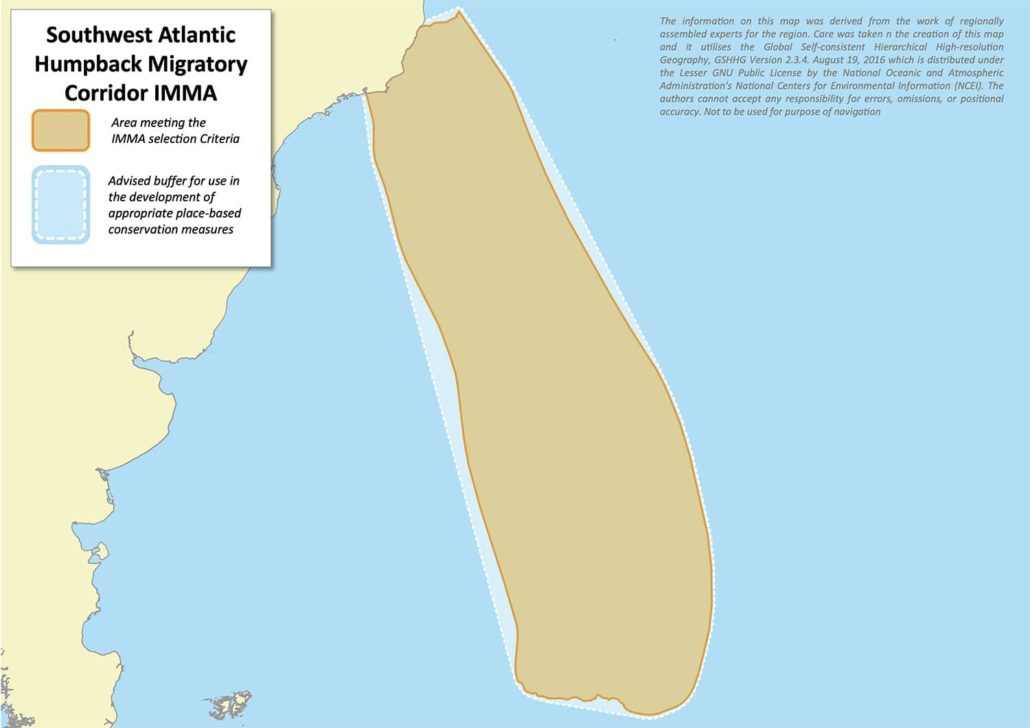Southwest Atlantic Humpback Migratory Corridor IMMA
Size in Square Kilometres
4 014 498 km2
Qualifying Species and Criteria
Humpback whale – Megaptera novaeangliae
Criterion C (3)
Download fact sheet
Summary
The southwest Atlantic humpback whale migratory corridor IMMA represents the main migratory route used by humpback whales (Megaptera novaeangliae australis) travelling between breeding and feeding grounds in the western South Atlantic. The IMMA extends from the main breeding habitat of this species in the Abrolhos Bank, Brazil (~18oS), to their primary foraging areas north of the Scotia Sea (~50-55oS). This IMMA includes different habitats that the whales pass through during their migration, including shallow waters of the continental shelf off Brazil and deeper waters of the Argentine Basin. It also includes notable physiographic features such as the Rio Grande rise, which may provide foraging opportunities for these migratory animals.
Description of Qualifying Criteria
Criterion C: Key Life Cycle Activities
Sub-criterion C3: Migration Routes
The IMMA encompasses the main migratory corridor of the western South Atlantic humpback whale population as determined by satellite tracking data (Zerbini et al., 2006; 2011; Bedriñana-Romano et al., 2022). The data are based on 22 adult (judged by their relatively large size) humpback whales of both sexes that were tagged on the main breeding ground in Abrolhos Bank and tracked between 2003 and 2019 for 40-275 days (Bedriñana-Romano et al. 2022). Migration speed of both males and females was around 5 km/h on average (versus 2-3km/h in feeding areas) and migration from breeding grounds in Brazil to sub-Antarctic feeding grounds lasted 38 days on average. The IMMA boundaries encompass the satellite tracks of 20 out of 22 individuals that were tagged and tracked during their entire southbound migration.
The northbound migration is less studied but at least two individuals satellite tracked on their return from the feeding grounds to Abrolhos Bank migrated from the Scotia Arc through the IMMA (Jackson et al., unpublished data, Zerbini et al., unpublished). However, it is possible that whales are using a habitat not included in this IMMA for their northbound migration, given the increasing frequency of early breeding season observations of humpback whales in nearshore areas southeast of Cabo Frio (hundreds of kilometers south of the main documented breeding grounds in Abrolhos Bank, Siciliano et al., 2019; Morete et al., 2022). However, further data are needed to assess this hypothesis and to determine the possible alternative northbound migration routes.
The IMMA connects another IMMA in Abrolhos Bank, Brazil which is a major known breeding area for this species, to the Scotia Arc IMMA which represents the main feeding grounds of western South Atlantic humpback whales (Zerbini et al., 2006; Engel and Martin, 2009; Reisinger et al., 2020; Bedriñana et al., 2022).
Supporting Information
Bedriñana-Romano, L., Zerbini, A.N., Andriolo, A., Danilewicz, D. and Sucunza, F. 2022. Individual and joint estimation of humpback whale migratory patterns and their environmental drivers in the Southwest Atlantic Ocean. Scientific Reports 12(1), 7487.
Engel, M.H. and Martin, A.R. 2009. Feeding grounds of the western South Atlantic humpback whale population. Marine Mammal Science 25(4), 964-69.
Martins, C.C.A., Morete, M.E., Engel, M.H., Freitas, A.C., Secchi, E.R. and Kinas, P.G. 2001. Aspects of habitat use patterns of humpback whales in the Abrolhos Bank, Brazil, breeding ground. Memoirs of the Queensland Museum 47(2), 563-70.
Morete, M.E., Marques, M.L., de Souza, R.C.F., Tristão, I.A., Motta, M.C., Martins, C.C.A., Cardoso, J. and Francisco, A. 2022. Is the reproductive area of the humpback whale (Megaptera novaeangliae) in Brazilian waters increasing? Evidence of breeding and calving activities around Ilhabela, São Paulo, Brazil. Latin American Journal of Aquatic Mammals 17(1).
Reisinger, R.R., Friedlaender, A.S., Zerbini, A.N., Palacios, D.M., Andrews-Goff, V., Dalla Rosa, L., Double, M., Findlay, K., Garrigue, C., How, J., Jenner, C., Jenner, M.-N., Mate, B., Rosenbaum, H.C., Seakamela, S.M. and Constantine, R. 2021. Combining Regional Habitat Selection Models for Large-Scale Prediction: Circumpolar Habitat Selection of Southern Ocean Humpback Whales. Remote Sensing 13(11), 2074.
Siciliano, S., Cardoso, J., Francisco, A. and Moreira, S.C. 2019. A stop for a snack: evidence of humpback whale (Megaptera novaeangliae) feeding behavior and association with gillnets during migration off southeastern Brazil. Boletim do Laboratório de Hidrobiologia 29: 41-49.
Zerbini, A.N., Andriolo, A., Heide-Jørgensen, M.P., Pizzorno, J.L., Maia, Y.G., VanBlaricom, G.R., DeMaster, D.P., Simões-Lopes, P.C., Moreira, S. and Bethlem, C. 2006. Satellite-monitored movements of humpback whales Megaptera novaeangliae in the Southwest Atlantic Ocean. Marine Ecology Progress Series 313, 295-304.
Zerbini, A.N., Andriolo, A., Heide-Jørgensen, M.P., Moreira, S.C., Pizzorno, J.L., Maia, Y.G., Bethlem, C., VanBlaricom, G.R. and DeMaster, D.P. 2011. Migration and summer destinations of humpback whales (Megaptera novaeangliae) in the western South Atlantic Ocean. J. Cetacean Res. Manage. (special issue 3), 113-18.


